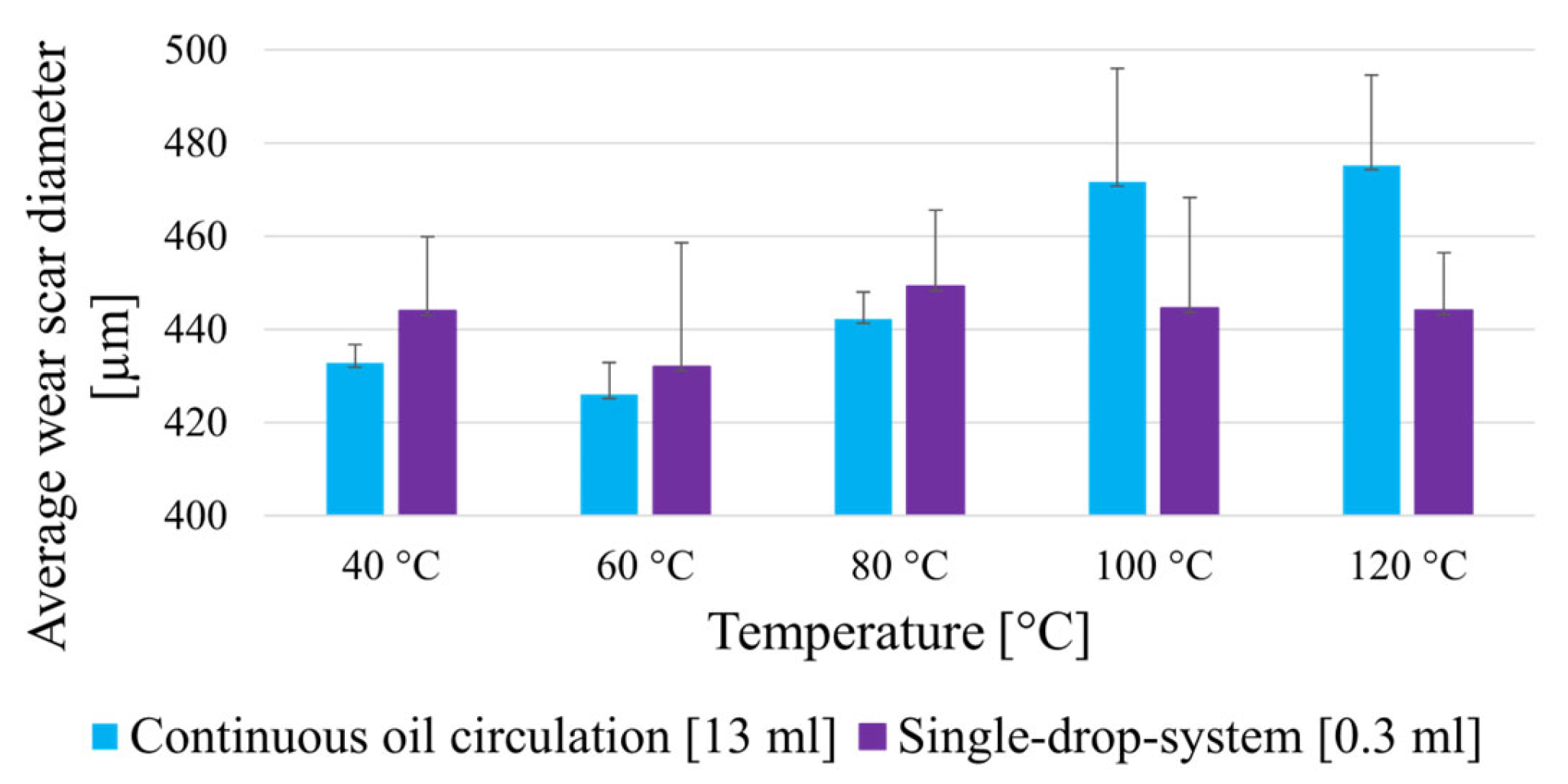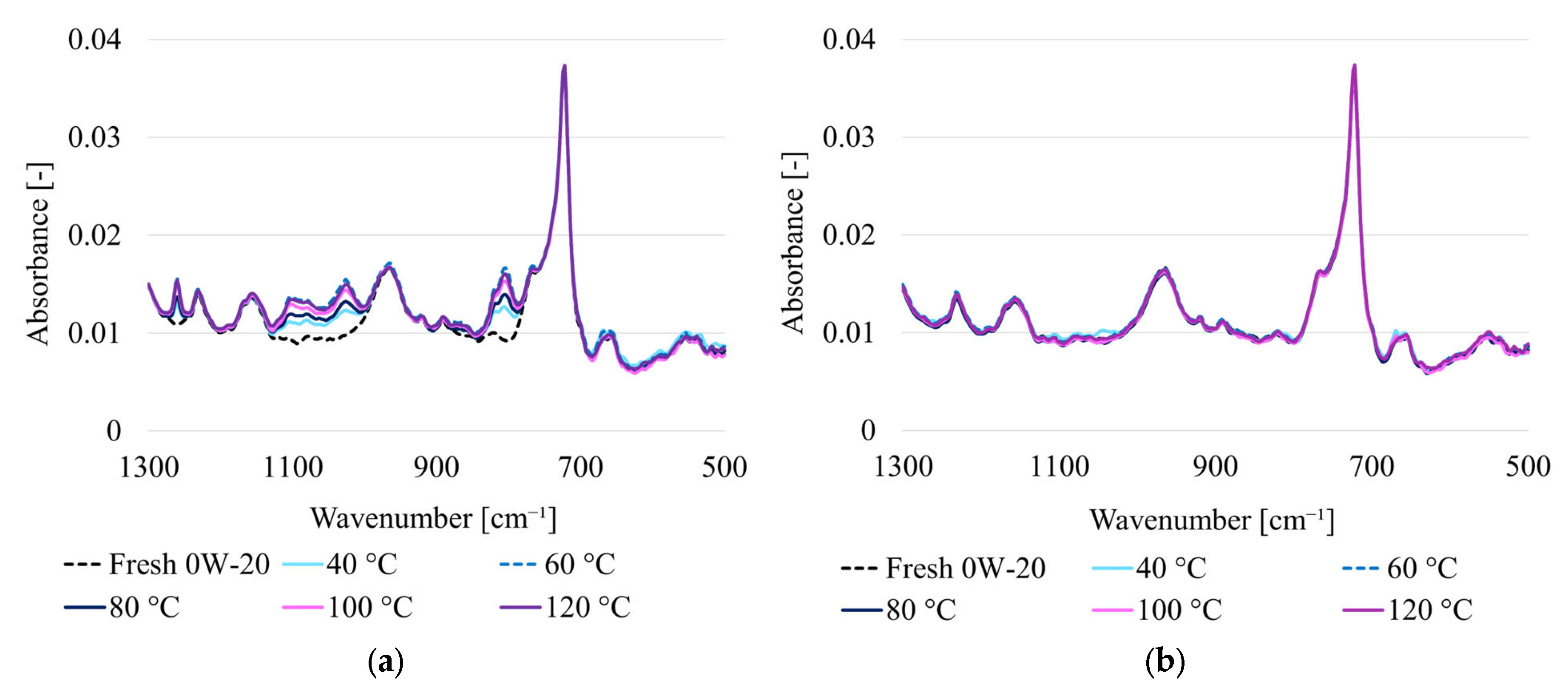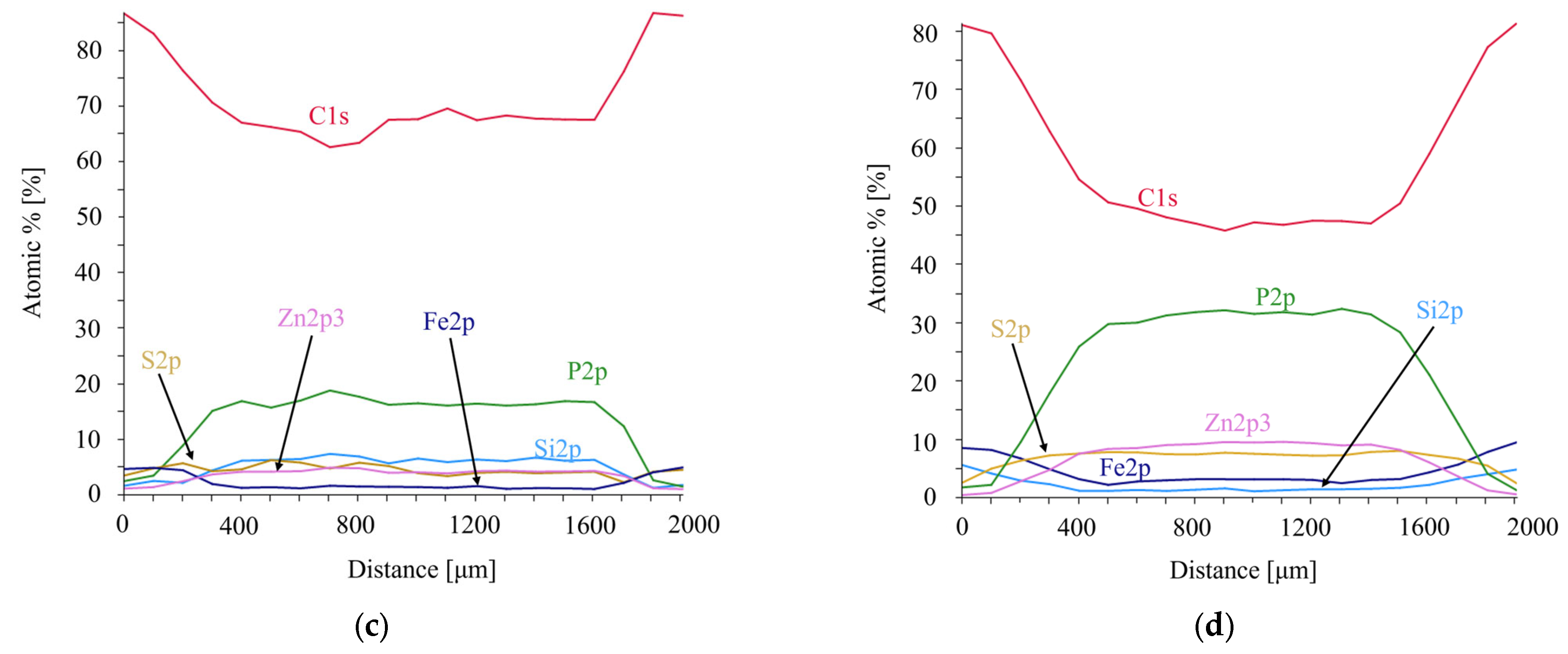Investigation of Silicone Contamination in Tribometer Experiments Using FT-IR and XPS Technology †
Abstract
1. Introduction
2. Materials and Methods
2.1. Tribological Experiments
2.2. Wear Analysis
2.3. Oil Analysis
2.4. Surface Analysis
3. Results and Discussion
3.1. FT-IR Analysis
3.2. XPS Analysis
4. Conclusions
Author Contributions
Funding
Institutional Review Board Statement
Informed Consent Statement
Data Availability Statement
Conflicts of Interest
References
- Khairallah, W.; Autay, R.; Bensalah, W.; Baouab, M.H.V. Tribological and mechanical behaviors of Fe3O4NPs reinforced UHMWPE biocomposite. J. Thermoplast. Compos. Mater. 2025, 38, 1950–1967. [Google Scholar] [CrossRef]
- Wos, S.; Koszela, W.; Pawlus, P. The effect of graphite surface texturing on the friction reduction in dry contact. Tribol. Int. 2020, 151, 106535. [Google Scholar] [CrossRef]
- Ferreira, R.; Carvalho, Ó.; Pires, J.; Sobral, L.; Carvalho, S.; Silva, F. A new tribometer for the automotive industry: Development and experimental validation. Exp. Mech. 2022, 62, 483–492. [Google Scholar] [CrossRef]
- Paulovics, L.; Kuti, R.; Rohde-Brandenburger, J.; Tóth-Nagy, C. Development of comparative investigation method for timing chain wear analysis using oscillating tribometer. Acta Tech. Jaurinensis 2021, 14, 406–423. [Google Scholar] [CrossRef]
- Tortora, A.M.; Veeregowda, D.H. Effects of two sliding motions on the superlubricity and wear of self-mated bearing steel lubricated by aqueous glycerol with and without nanodiamonds. Wear 2017, 386, 173–178. [Google Scholar] [CrossRef]
- Thachnatharen, N.; Khalid, M.; Arulraj, A.; Sridewi, N. Tribological performance of hexagonal boron nitride (hBN) as nano-additives in military grade diesel engine oil. Mater. Today Proc. 2022, 50, 70–73. [Google Scholar] [CrossRef]
- Forder, M.D.; Morris, N.; King, P.; Balakrishnan, S.; Howell-Smith, S. An experimental investigation of low viscosity lubricants on three piece oil control rings cylinder liner friction. Proc. Inst. Mech. Eng. Part J J. Eng. Tribol. 2022, 236, 2261–2271. [Google Scholar] [CrossRef]
- Idzior, M. Aging of engine oils and their influence on the wear of an internal combustion engine. Combust. Engines 2021, 185, 15–20. [Google Scholar] [CrossRef]
- Agocs, A.; Nagy, A.L.; Tabakov, Z.; Perger, J.; Rohde-Brandenburger, J.; Schandl, M.; Dörr, N. Comprehensive assessment of oil degradation patterns in petrol and diesel engines observed in a field test with passenger cars–Conventional oil analysis and fuel dilution. Tribol. Int. 2021, 161, 107079. [Google Scholar] [CrossRef]
- Agocs, A.; Besser, C.; Brenner, J.; Budnyk, S.; Frauscher, M.; Dörr, N. Engine oils in the field: A comprehensive tribological assessment of engine oil degradation in a passenger car. Tribol. Lett. 2022, 70, 28. [Google Scholar] [CrossRef]
- Dörr, N.; Brenner, J.; Ristić, A.; Ronai, B.; Besser, C.; Pejaković, V.; Frauscher, M. Correlation between engine oil degradation, tribochemistry, and tribological behavior with focus on ZDDP deterioration. Tribol. Lett. 2019, 67, 62. [Google Scholar] [CrossRef]
- Agocs, A.; Budnyk, S.; Besser, C.; Ristic, A.; Frauscher, M.; Ronai, B.; Dörr, N. Production of used engine oils with defined degree of degradation in a large-scale device: Correlation of artificially altered oils with field samples. Acta Tech. Jaurinensis 2020, 13, 131–150. [Google Scholar] [CrossRef]
- Heredia-Cancino, J.A.; Carrillo-Torres, R.C.; Félix-Domínguez, F.; Álvarez-Ramos, M.E. Experimental characterization of chemical properties of engine oil using localized surface plasmon resonance sensing. Appl. Sci. 2021, 11, 8518. [Google Scholar] [CrossRef]
- Akbari, S.; Kovač, J.; Kalin, M. Effect of ZDDP concentration on the thermal film formation on steel, hydrogenated non-doped and Si-doped DLC. Appl. Surf. Sci. 2016, 383, 191–199. [Google Scholar] [CrossRef]
- Conklin, A., Jr.; Goldcamp, M.J.; Barrett, J. Determination of ethanol in gasoline by FT-IR spectroscopy. J. Chem. Educ. 2014, 91, 889–891. [Google Scholar] [CrossRef]
- Ueda, M.; Spikes, H. ZDDP tribofilm formation and removal. Tribol. Lett. 2024, 72, 109. [Google Scholar] [CrossRef]
- Costa, H.L.; Evangelista, K.S.; Cousseau, T.; Acero, J.S.R.; Kessler, F. Use of XANES and XPS to investigate the effects of ethanol contamination on anti-wear ZDDP tribofilms. Tribol. Int. 2021, 159, 106997. [Google Scholar] [CrossRef]
- Lee, J.N.; Park, C.; Whitesides, G.M. Solvent compatibility of poly(dimethylsiloxane)-based microfluidic devices. Anal. Chem. 2003, 75, 6544–6554. [Google Scholar] [CrossRef] [PubMed]
- Johnson, L.M.; Gao, L.; Shields IV, C.W.; Smith, M.; Efimenko, K.; Cushing, K.; López, G.P. Elastomeric microparticles for acoustic mediated bioseparations. J. Nanobiotechnol. 2013, 11, 22. [Google Scholar] [CrossRef] [PubMed]
- ISO 19291:2016(E); Lubricants—Determination of Tribological Quantities for Oils and Greases—Tribological Test in the Translator Oscillation Apparatus. International Organization for Standardization: Geneva, Switzerland, 2016.
- NIST X-Ray Photoelectron Spectroscopy Database. Available online: https://srdata.nist.gov/xps/ (accessed on 12 June 2025).






| Specimen | Material | Dimension | Hardness | Roughness |
|---|---|---|---|---|
| Disc | 100Cr6 | ø 24 × 7.9 mm | 62 HRC | Ra 0.047 µm |
| Ball | 100Cr6 | ø 10 mm | 61.5 HRC | Ra 0.02 µm |
| Continuous Oil Flow [13 mL] | Single-Drop System [0.3 mL] | ||
|---|---|---|---|
| Temperature [°C] | Load [N] | Temperature [°C] | Load [N] |
| 40 | 150 | 40 | 150 |
| 60 | 60 | ||
| 80 | 80 | ||
| 100 | 100 | ||
| 120 | 120 | ||
Disclaimer/Publisher’s Note: The statements, opinions and data contained in all publications are solely those of the individual author(s) and contributor(s) and not of MDPI and/or the editor(s). MDPI and/or the editor(s) disclaim responsibility for any injury to people or property resulting from any ideas, methods, instructions or products referred to in the content. |
© 2025 by the authors. Licensee MDPI, Basel, Switzerland. This article is an open access article distributed under the terms and conditions of the Creative Commons Attribution (CC BY) license (https://creativecommons.org/licenses/by/4.0/).
Share and Cite
Kovács, M.; Pintér, D. Investigation of Silicone Contamination in Tribometer Experiments Using FT-IR and XPS Technology. Eng. Proc. 2025, 113, 69. https://doi.org/10.3390/engproc2025113069
Kovács M, Pintér D. Investigation of Silicone Contamination in Tribometer Experiments Using FT-IR and XPS Technology. Engineering Proceedings. 2025; 113(1):69. https://doi.org/10.3390/engproc2025113069
Chicago/Turabian StyleKovács, Márkó, and Dominika Pintér. 2025. "Investigation of Silicone Contamination in Tribometer Experiments Using FT-IR and XPS Technology" Engineering Proceedings 113, no. 1: 69. https://doi.org/10.3390/engproc2025113069
APA StyleKovács, M., & Pintér, D. (2025). Investigation of Silicone Contamination in Tribometer Experiments Using FT-IR and XPS Technology. Engineering Proceedings, 113(1), 69. https://doi.org/10.3390/engproc2025113069






